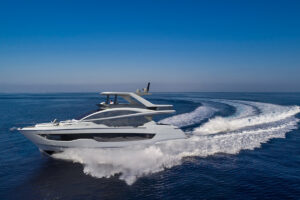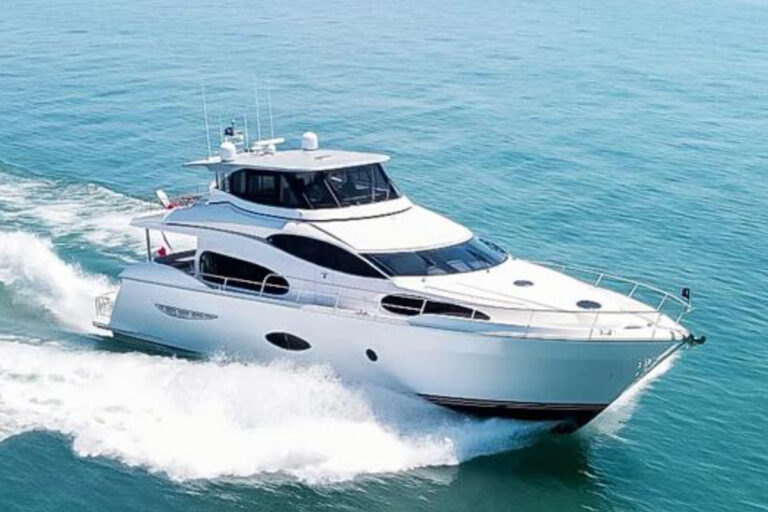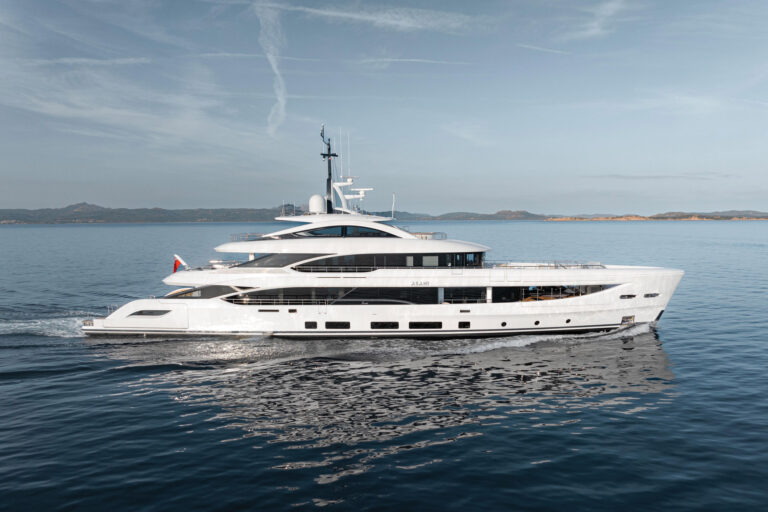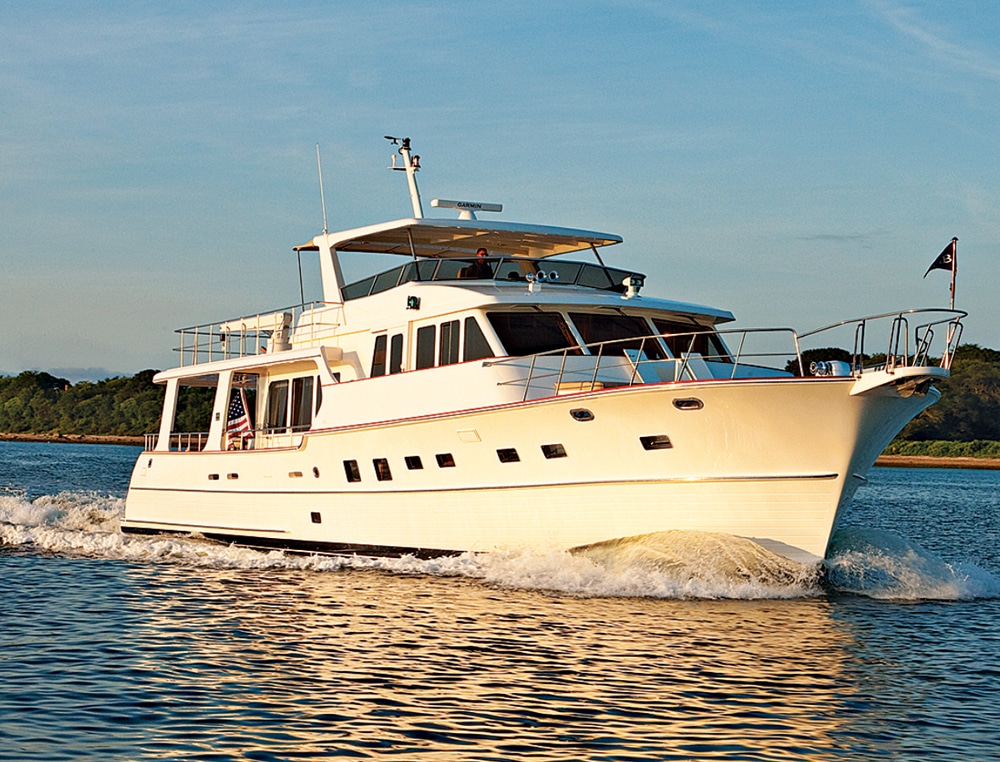
Grand Banks 72 Aleutian SC
“Now’s probably a bad time to tell you I’m afraid of heights,” announced Tucker West, the North American sales manager for Grand Banks Yachts, as he squeezed his 6-foot, 5-inch frame into a miniscule opening in the freighter’s deck. He then disappeared like a rabbit, descending four decks through a dimly lit passageway. At the bottom of the oil-coated ladder, the new Grand Banks 72 SC awaited us as the commissioning crew cut away the layers of shrink-wrap to free her from the cradle and place her back in the water where she belonged.
Over the years, I’ve tested boats in a variety of conditions, yet this was the first time that I needed stevedores to complete their job before I started the review process. But it was all part of the grand plan. This situation presented the ideal scenario for testing a new boat — fresh out of the box. After we took on some fuel and a few provisions, we would continue on from Portsmouth, Virginia, up the coast to Rowayton, Connecticut — an even better way to shake down a new model.
The Grand Banks 72 Aleutian SC is the latest addition to the builder’s raised pilothouse Aleutian series. The line includes the 53 RP, launched this summer; and the successful Sparkman & Stephens-designed 59, of which 40 have been built since 2007; the 65; and the 72 RP with a cockpit. When the original Tom Fexas-designed Aleutian 64 was introduced in 2001, the hull mold was 72 feet. It was then damned to create the 64, which later evolved into the newer 65.
The 72 SC replaces the cockpit with a larger, covered afterdeck, which allows decent-size crew accommodations. She is designed to coastal cruise and island-hop with six to eight people comfortably. (Fewer people equals more comfort.) “We’re taking advantage of the downtime resulting from the slower market to re-engineer systems and models,” said David Hensel, director of brand and marketing for Grand Banks Yachts.
My initial knee-jerk reaction when comparing the cockpit version with the new SC model was if you were more involved in water sports, you should go with the 72 RP with the cockpit. However, after a few days aboard, I realized that unless you’re planning on landing a great white, the 72 SC still offers very good water access, thanks to the double stairway that leads from the after deck to the larger swim platform. Putting on dive tanks or loading up the tender will be an easy affair. Safety rails can be installed as well along the edge. The covered aft deck has a large teak table that can accommodate eight during mealtime.
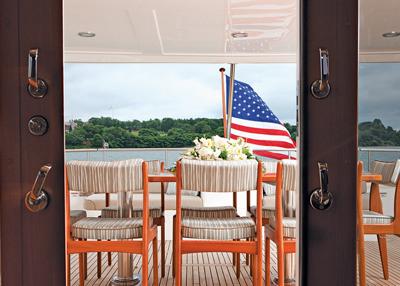
At 72 feet, some owners may wish to employ a captain or, at the very least, a deckhand to help with a washdown at the end of the day. To meet this demand, nicely finished crew accommodations are accessed through a watertight transom door or a ladder via the deck. There are twin bunks, a wethead, and a side-by-side washer and dryer. If an owner has zero plans for crew, this area could also double as a spacious workshop and stowage area.
Forward of the crew area is the engine room access. Batteries are placed so that they can be removed, the Racor fuel filters are on the forward bulkhead for service, and the standing headroom was a surprise considering the 72’s relatively low profile. Our test boat had an optional second 22 kW generator. Both units are mounted abaft the engines. There are generally two schools of thought when considering the kilowatt output of a secondary generator. The first is to go with a smaller unit that would be sufficient to carry nighttime loads only. You turn this off in the morning and power up the larger unit during the day to run heavy-load items such as appliances and air-conditioning units. Or, as in the 72, you have a duplicate unit in case you need a part that is not in your spare inventory. You alternate between generators while cruising. That would be my recommendation on this particular boat. With six a/c chiller systems, several refrigerators and freezers, and plenty of methods of drawing down power, you won’t have to worry about keeping a sufficient load on a 22 kW genset.
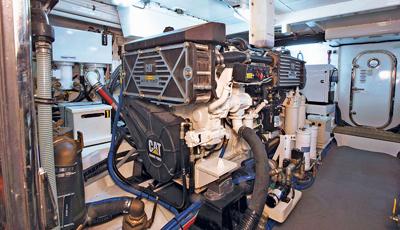
Our test boat featured one main fuel tank and four auxiliary tanks. There is a manual, electric transfer system that feeds the main tank. At first, I admit that this struck me as overly complicated for a 72-footer. However, after Chris Keenan, an old friend and a professional captain employed for the 72’s delivery, walked me through the process, I realized it’s easily managed. Just be sure that the CompuTank monitoring system is calibrated, and keep track of what you’re moving around.
If there is ever a moment when you pray for the engines to start, it’s when you’re dangling in a crane’s slings, in 20 knots of wind, off the transom of a container ship. The pleas worked! The 1,015-horsepower Caterpillar C18 ACERT diesels roared to life. Keenan was charged with the not-so-enviable job of backing us out of the slings toward the imposing bulkead. In short order we were on our way to Portsmouth to pick up some fuel and bad lunchmeat for the trip north.
Each new Grand Banks comes off the ship wrapped like a special gift. The more tape and protective covering we pulled off, the more the new 72 SC began to reveal herself. It was as if she breathed a sigh of relief. Teak decks cover the afterdeck while a painted, grippy nonskid is used for the side decks and flybridge. As an aside, as much as I like the look and feel of teak decks, the effort required to clean them on the bridge is often not worth the aesthetic and functional trade-off, in my opinion. Furthermore, it adds additional weight above the deck.
The bridge was properly laid out for cruising, with a 13- foot tender, ice maker, refrigerator, a smallish electric grill and plenty of seating for relaxing while underway. There is a curved staircase to the aft deck, as well as access to the pilothouse from the forward stairs. Our test boat featured a fiberglass hardtop and radar arch. The profile was well designed and didn’t detract from the 72’s aesthetics. However, a canvas extension is affixed to the after end of the arch to provide additional protection. In my opinion, this looks too much like an afterthought on an approximately $4 million boat and will eventually need to be replaced. If this was fiberglass to match the arch and hardtop, it would complete the picture.
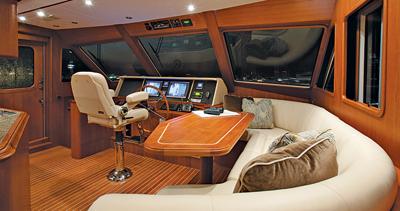
In keeping with Grand Banks’ nod to tradition, teak caprails line the bulwark, and all of the deck hardware is substantial and flawlessly executed. A fiberglass rub rail extends below the caprail as well as down the middle of the topsides, allowing peace of mind while pivoting off pilings.
The same cruising details extend to the forward deck where you’ll find double rollers on the fiberglass anchor platform. Hallelujah! If you’ve ever anchored in a tricky current against wind, or in foul weather, you’ll know that a secondary anchor is a crucial piece of cruising equipment.
After we added another 1,500 gallons of diesel to the 2,625-gallon capacity, Tucker West and I installed the radar array for the Garmin 5215. Bit by bit, this baby was beginning to look like a proper ship. We rigged the mast and navigation lights, while Keenan reviewed the mechanical systems and prepared the boat for an early morning departure.
Our plan was to cruise from Norfolk, stop over in Atlantic City, New Jersey, and then continue on to Long Island Sound the following morning. As much as I would have loved to go straight through and experience the 72’s functional pilothouse at night, navigating New York’s bustling harbor in the dark on a brand-new boat would have created more stress than necessary.
We did not have the flybridge fully rigged, so we retreated to the shelter of the pilothouse as we cruised up the coast the next day. Surrounded by the builder’s signature teak finish, and shippy details, my wanderlust — which I ward off on a constant basis — attempted to claw its way to the surface. Two side doors provide cross ventilation and easy access to the deck. The single Stidd helm seat had a commanding view, and the starboard dinette provided an area to lay out a chart and plan our day. I would have liked to see a smaller remote breaker panel for items such as wipers, electronics and navigation lights at each helm for easier access. This would avoid climbing down into the passageway to access the main DC breaker panel to activate these constantly used pieces of equipment. The fully equipped galley is abaft the helm.
The full, optional Garmin electronics suite was perfectly integrated into the 72’s helm. The two 15-inch monitors for the 5215 series were easily viewed and manipulated. Since you can split these screens to show a variety of data, including depth, radar, chart, engine systems, and cameras, everything is right in front of the helmsman. There was additional space for another monitor if you wish to install an onboard PC.
The gentle, easy motion of the 72 reminded me of offshore deliveries on previous Grand Banks models such as the venerable 42, 46 and 49, which also had a speed sweet spot in the mid to upper teens. (Full disclosure: I worked for Grand Banks for several years in the mid ’90s.) At 1,800 rpm or 63 percent of load, we settled into an easy cruising speed of 15 knots in the three-foot swells, while burning 60 gallons per hour. Pushing the throttles forward to 2,000 rpm jumped her up to a speed of 18.5 knots. You can expect a top speed of approximately 23 knots.
If you want to head up Alaska’s Inside Passage, or from Florida to the Virgin Islands, pull the throttles all the way back to 1,200 rpm, put your waypoint in, and enjoy the 10.7-knot cruise speed for the next 1,000 miles. Grand Banks also offers the 1,100-horsepower version of the C18. However, our test engine configuration seemed appropriate for the design.
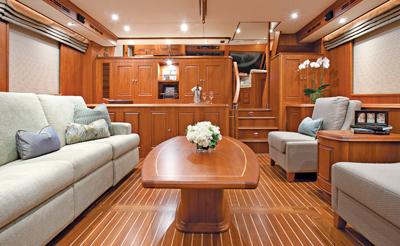
Once we arrived in Atlantic City, we discovered that about the only option for a decent meal that wasn’t going to break the bank was Hooters. To be honest, my first foray into fried pickles wasn’t completely devoid of a perverse satisfaction. Afterwards, we continued to assault the coverings and protective coatings on the interior, anxious to make the 72 look more and more like a yacht with every rip. Well, that and we were motivated by the desire to not sleep on plastic. Keenan took the full-beam master with the walk-around queen berth. Large ports bring in light to the stateroom. The head with his-and-her sinks and a shower stall are abaft the berth. There is also another entrance into the engine room from this area.
Our test boat featured an optional four-stateroom, threehead arrangement. I took the office/stateroom combo on the starboard side and was more than comfortable. Shoji screens conceal the opening ports with deadlights. As an aside, I would have liked to see a method for securing these in the open position while running. When you’re underway, maybe off watch and taking a nap, you may want to bring in some natural light without these banging around.
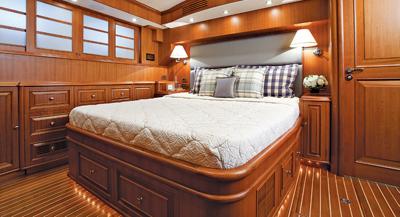
An additional guest stateroom is to starboard, featuring twin berths. The larger guest stateroom is forward with an island berth, an en suite head, and great ventilation.
Our final leg to Rowayton was effortless. Keenan easily maneuvered the 72 into her tight slip on the Five Mile River. While jumping down to the floating dock, I looked up toward the imposing bow and realized that this was indeed a little ship. Her looks were timeless, and the attention to detail was what we’ve come to expect from this nearly 55-year-old builder. You package this together with a thoughtfully designed coastal cruiser, and it’s safe to say that this is a worthy addition to the Grand Banks family.
LOA: 76’1″
LWL: 66’11”
Beam: 19’10”
Draft: 5’4″
Displ.: 120,000 lb.
Fuel: 2,625 gal.
Water: 250 gal.
Engine Options: 2 x 1,100-hp Caterpillar C18 ACERT diesels
Engines Tested: 2 x 1,015-hp Caterpillar C18 ACERT diesels
Base Price: Price upon request
Grand Banks Yachts, 206-352-0116; grandbanks.com




